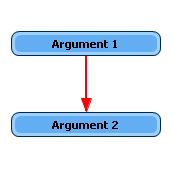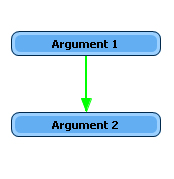This section describes the basic elements, organizational structures and dependencies in Argunet. This basic knowledge is essential for a deeper understanding of Argunet, but you can skip it if you want to start working with Argunet at once. In this case start with Chapter 2, Sketching a debate.
For a general overview, it is important to understand the hierarchy levels above and below argument maps in Argunet. They are illustrated in the following diagram:
The basic elements in Argunet are sentences, which can be contained in multiple argument maps as well as in multiple arguments. Arguments can likewise occur in multiple argument maps.
Apart from sentences and arguments, argument maps also contain attack and support relations (arrows). Sentences and arguments can also be grouped within an argument map. (see Section 2, “Grouping arguments”).
Debates are often so complex that they cannot be represented in a single argument map. The debate might change over time, it might include sub-debates, or one might decide to reconstruct certain areas in depth.
For this reason, debates are not the same as argument maps. Rather, any number of argument maps can be constructed within a debate. Thus, debates are independent objects one hierarchy level above argument maps (in the diagram: one level below).
Debates can be saved either on an  Argunet server
or
Argunet server
or  locally on your computer.
locally on your computer.
The basic elements of an Argunet argument map are single sentences, such as "CO2 emission should be reduced", "Mount Everest is the highest mountain on earth", "The Rolling Stones were wilder than the Beatles" or "Berlin is the capital of France". Each debate has its own sentence pool.
The sentences from such a pool can be part of an argument map in two different ways. They can either be inserted into the argument map directly, or they can be used in the premiss-conclusion-structure of arguments.
Once they have been reconstructed logically, arguments consist of sentences contained in the sentence pool of a debate. A simple argument contains two types of sentences. A sentence for which reasons are given and sentences which give reasons for this sentence. The former is called conclusion, the latter are called premisses. For example, "Socrates is a human being. All human beings are mortal. Thus Socrates is mortal." is a simple argument that contains three sentences. The first two sentences are its premisses, the third sentence is its conclusion.
Just as each debate contains a sentence pool which can be used in all argument maps and arguments of the debate, each debate also has an argument pool which can be used in all argument maps of the debate.
Caution
One and the same sentence can appear in several arguments, it can even appear in several argument maps within the same debate. (For example, the sentence "All human beings are mortal" could also appear in the argument "Aristotle is a human being. All human beings are mortal. Thus Aristotle is mortal.")
If such a sentence is changed in one location (in an argument, for example), then it changes in all other locations of the debate, too (in all arguments and all argument maps)!
The same applies to arguments in the argument pool.
Sentences are represented as framed boxes with a white background in the argument map, arguments as boxes with a coloured background. If an argument has already been reconstructed it appears with a broad frame. When the argument is opened by double-clicking on it in the argument map, the premiss-conclusion-structure of the argument appears in the argument editor.
Argunet argument maps consist only of sentences and arguments contained in the sentence or argument pools of the debate. There are only two possible relations between these elements, an element can attack or support another. An attack is represented with a red arrow, a support relation with a green arrow.
As soon as these relations have been reconstructed logically, they can be linked to two relations between sentences. An argument supports a sentence if and only if the conclusion of the argument is equivalent to the sentence. For example, the sentences "Socrates is mortal" and "Socrates has the property of being mortal" are equivalent. An argument attacks a sentence if and only if its conclusion contradicts (is contrary to) the sentence, such as "Socrates is mortal" and "Socrates cannot die". These relations not only hold between arguments and sentences, but also between two arguments. For more information, see Chapter 3, The logical reconstruction.
Just as arguments and sentences, these sentence relations are saved map-independently for the entire debate. First, equivalence classes of equivalent sentences are formed. Contradictions between sentences then also hold between the associated equivalence classes.
This has many advantages.
- Manual relation management is simplified considerably.
- When the reconstruction is extended or changed, Argunet can deduce many relations automatically from the defined relations.
- The reconstruction remains coherent and consistent.
- The participants in a debate are forced to restrict themselves to uncontroversial relations between sentences.
- The person reconstructing the debate has to keep the dialectical context in mind when reconstructing a single argument.
Important
Just as the map-independent sentence and argument pools, the relations between arguments and sentences are also saved map-independently in a pools of relations. If you don't keep this in mind, you may be surprised when Argunet inserts relations (arrows) automatically.
Caution
Relations defined in an argument map will affect a) all occurrences of theses sentences and b) all other sentences which were defined as equivalent to one of these sentences!
Caution
Changing the wording of a sentence will not delete the existing relations! In order to delete relations, the corresponding arrows in the argument map have to be deleted. See also Section 3, “Deleting and restoring elements”.



